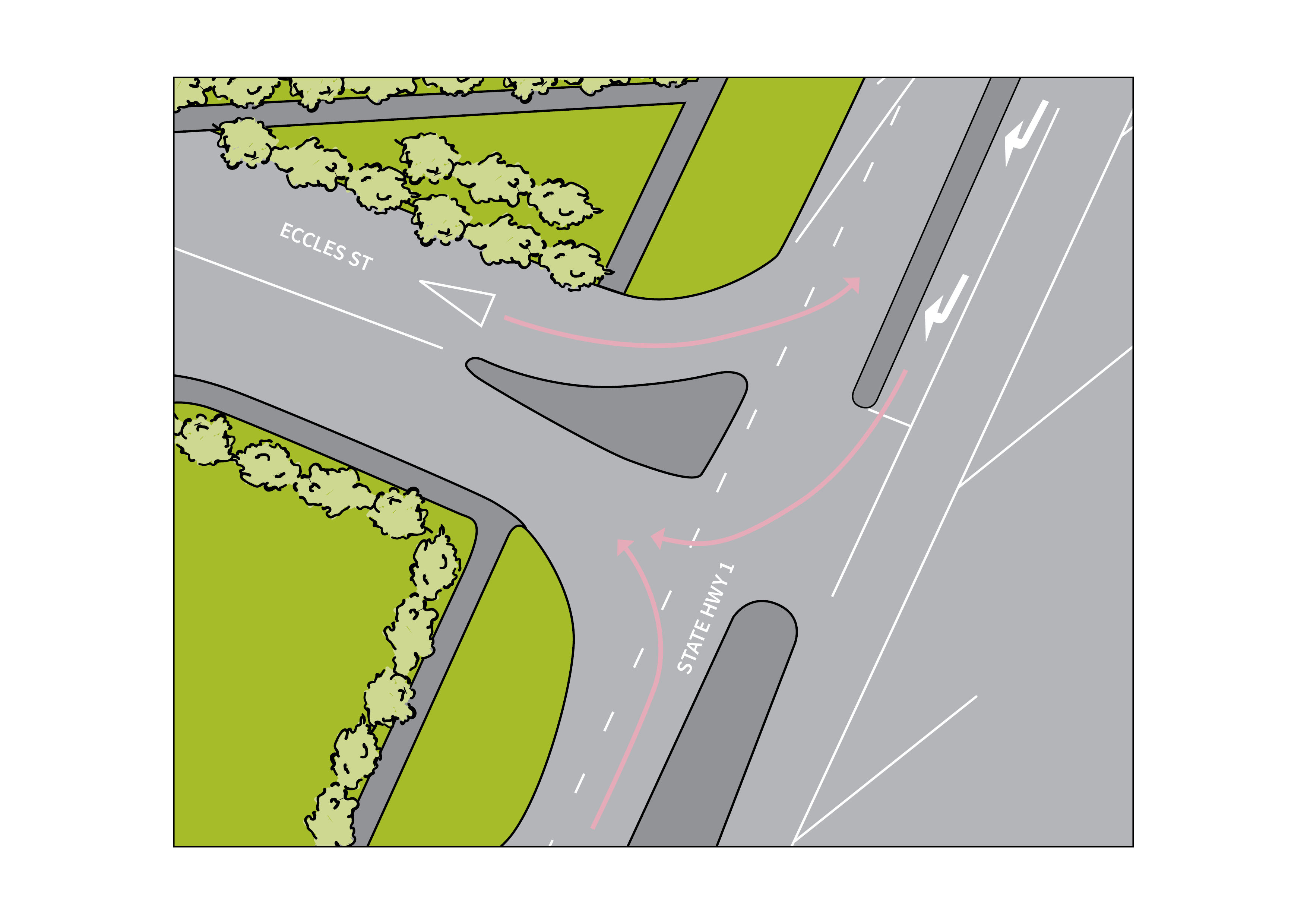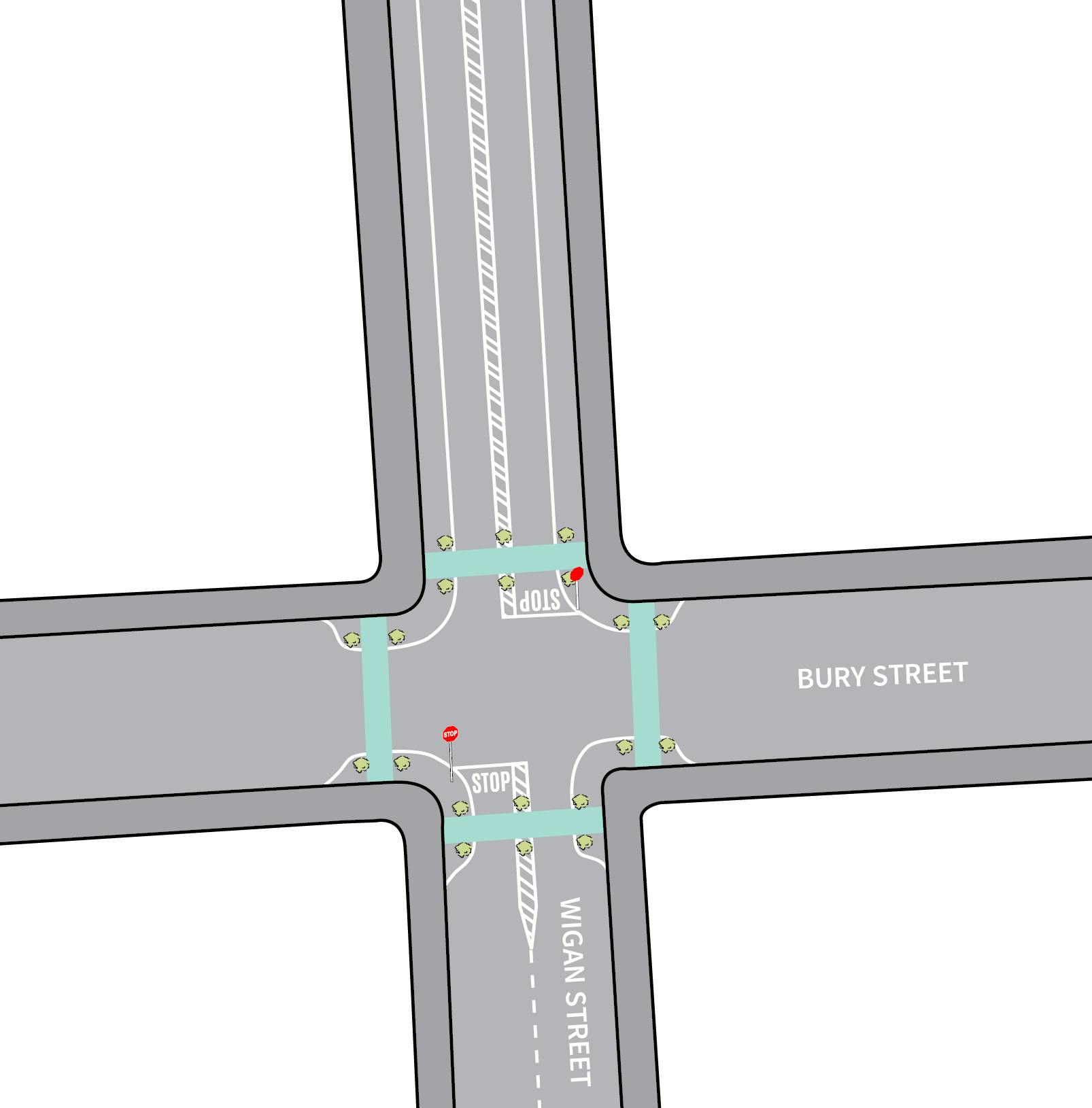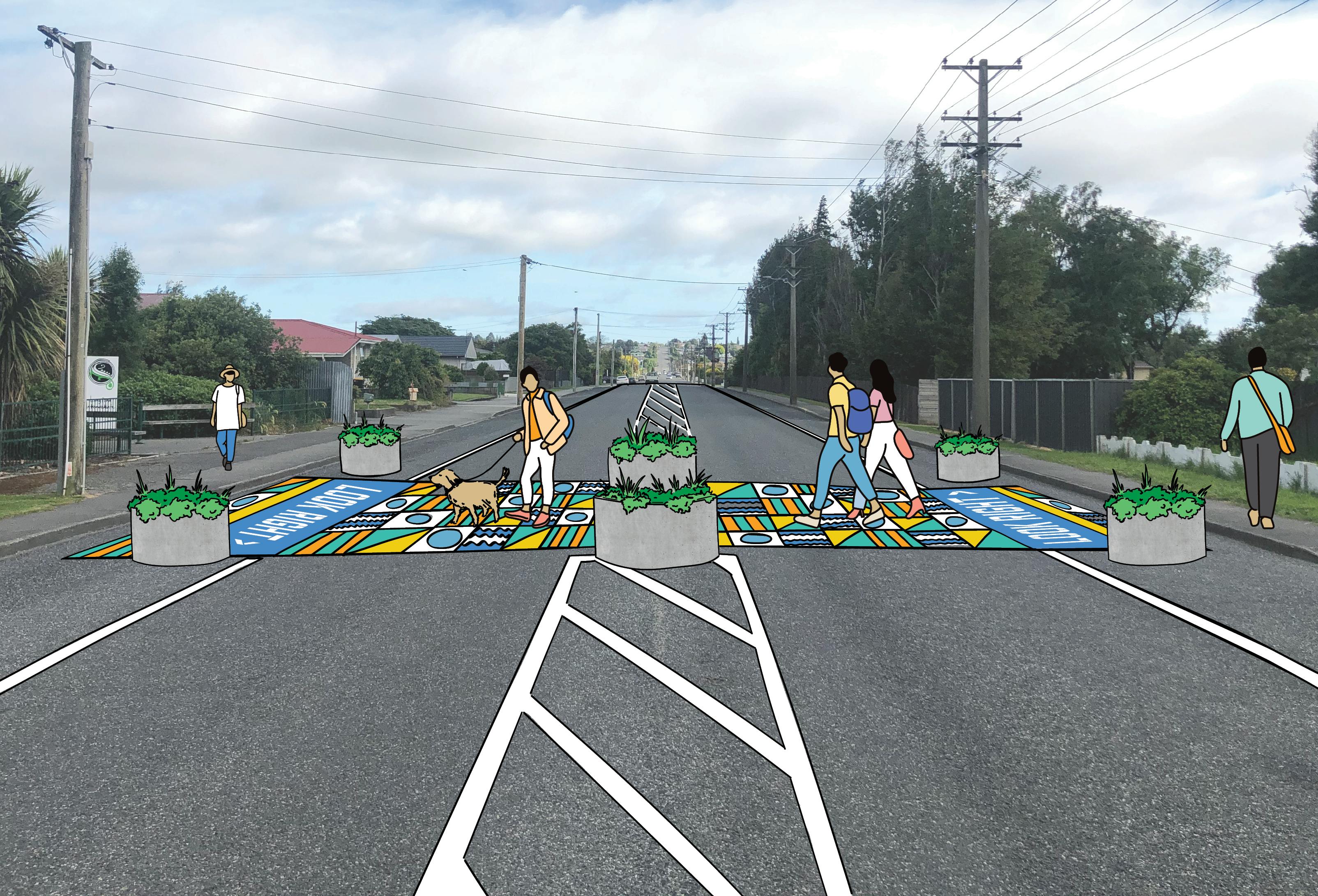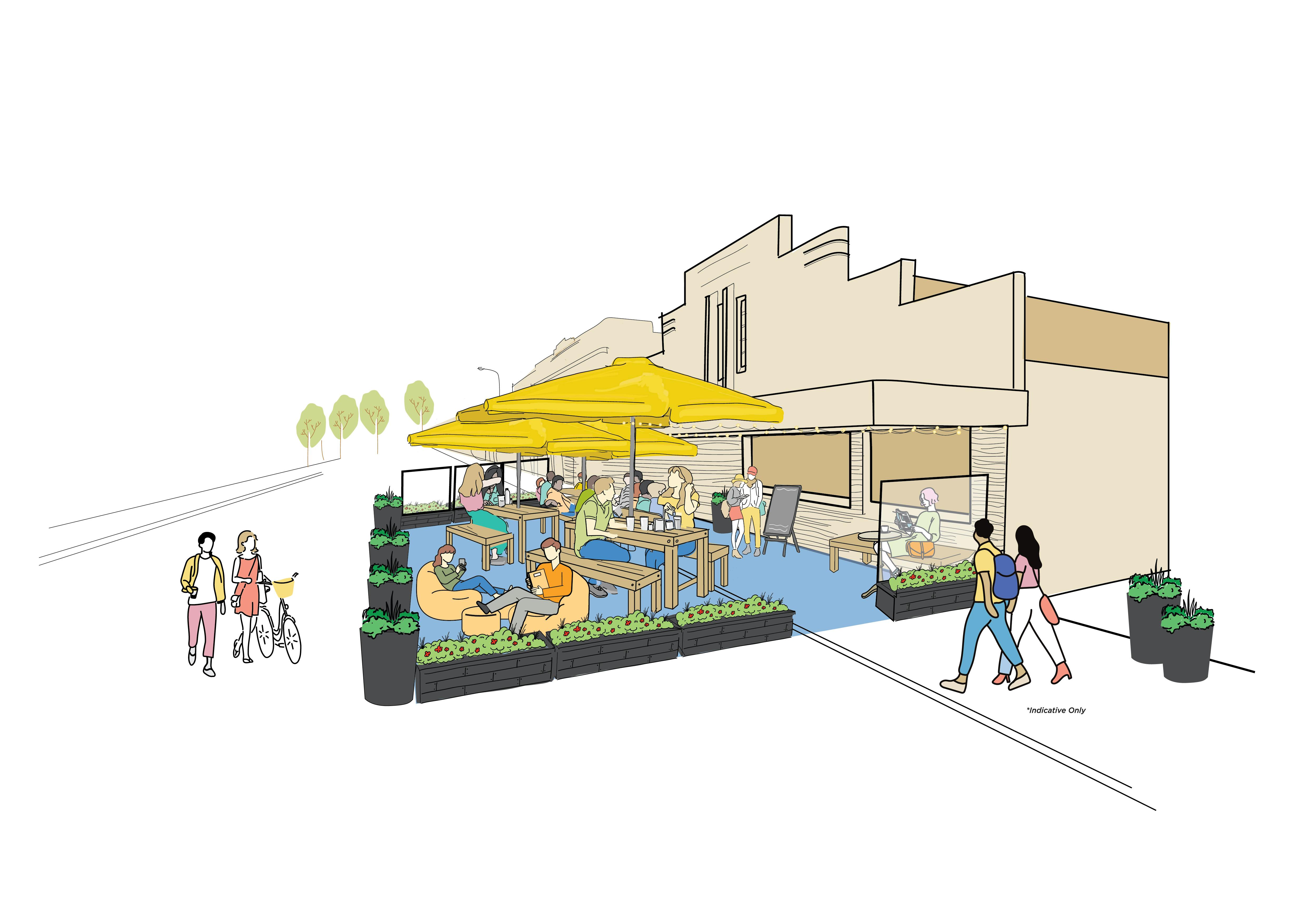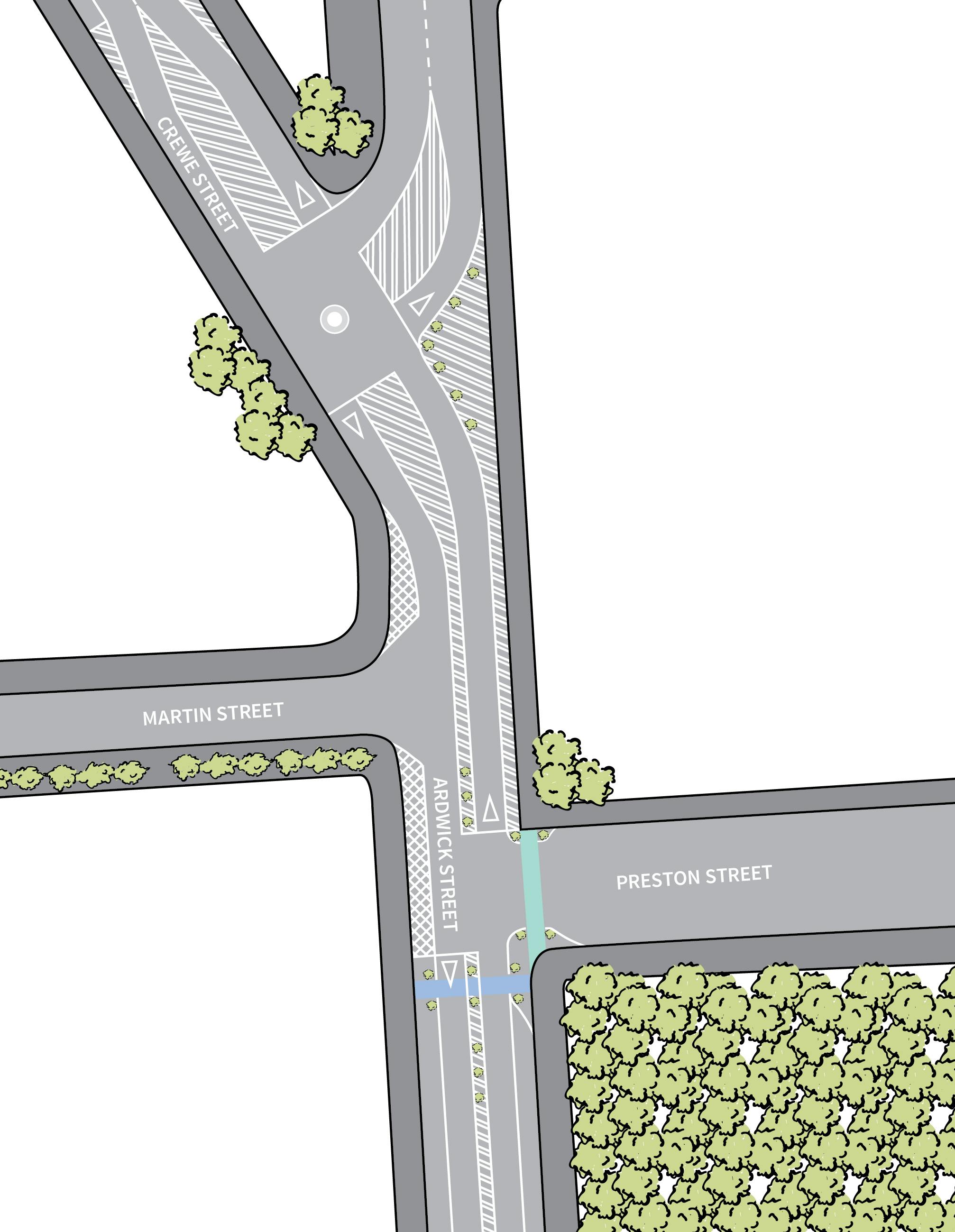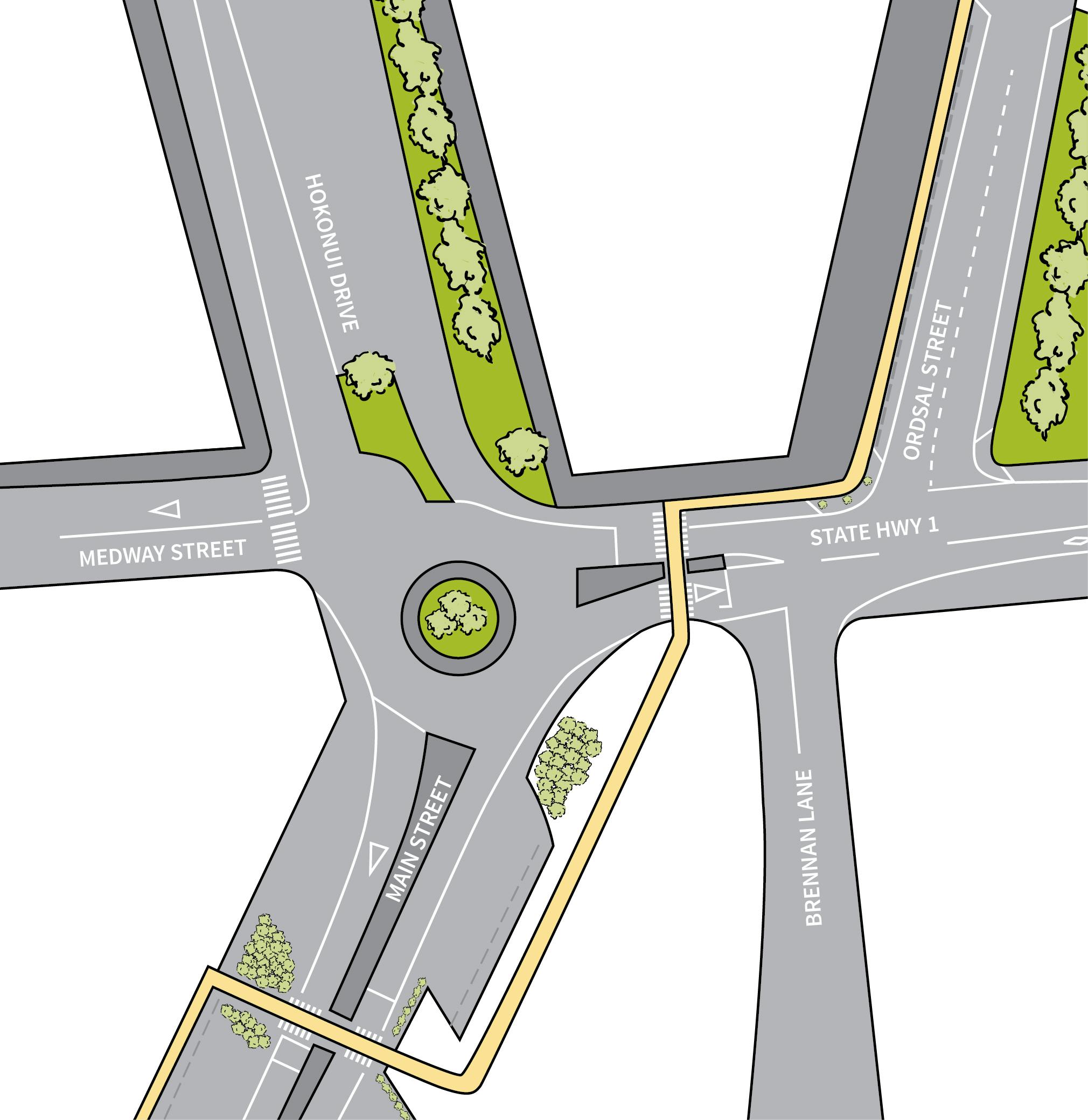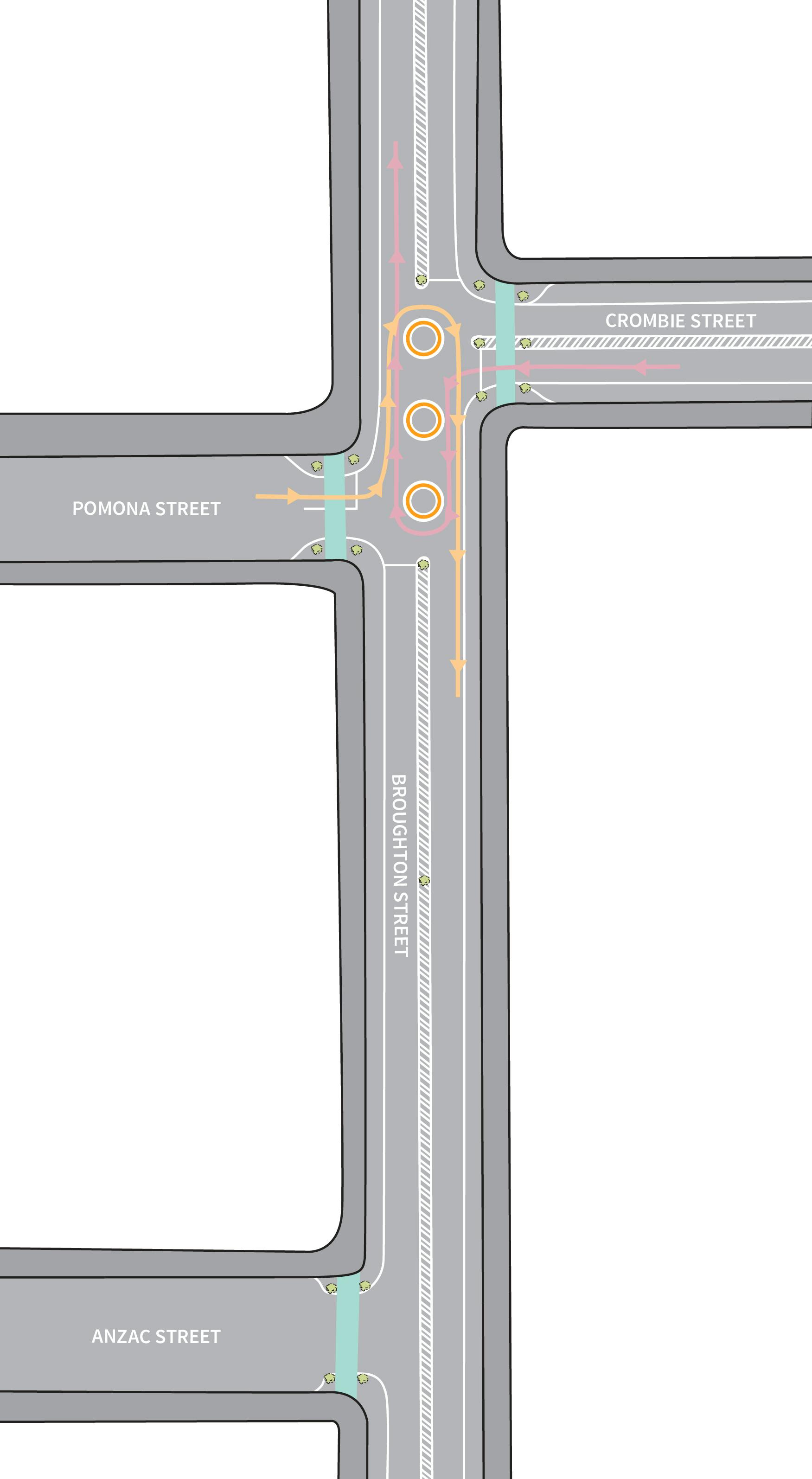Streets Alive - Shaping Gore's Future
Thanks to everyone for their involvement in this year long project.

Streets Alive - next steps
With the Streets Alive trials over, there’s still a few initiatives we’re working on finalising. One of these is traffic flow at the intersection of Eccles Street and Main Street.
We have been trialling a left-hand turn only for traffic coming out of Eccles Street on to Main Street (SH1). It seems to be working well and we are considering making it permanent. Before we go any further though, we want to hear your thoughts.
What’s proposed
North and south-bound traffic can enter Eccles Street off Main Street, but traffic won’t be able to turnContinue reading
Streets Alive - next steps
With the Streets Alive trials over, there’s still a few initiatives we’re working on finalising. One of these is traffic flow at the intersection of Eccles Street and Main Street.
We have been trialling a left-hand turn only for traffic coming out of Eccles Street on to Main Street (SH1). It seems to be working well and we are considering making it permanent. Before we go any further though, we want to hear your thoughts.
What’s proposed
North and south-bound traffic can enter Eccles Street off Main Street, but traffic won’t be able to turn right when exiting Eccles Street on to Main Street.
Sound confusing? Just think about the layout at the intersection of Irk and Main Streets – this would be the same.
Why change
Safety and traffic congestion are the main reasons for the proposed layout change.
If you think there’s been an increase in the traffic on the Main Street recently, you’re right.
Waka Kotahi NZTA figures show that between May 2020 and April 2021 there was a 54% increase in traffic along this section of state highway.
This increase in traffic means a right hand turn out of Eccles Street takes a lot longer. This adds to congestion and is dangerous as impatient drivers take their chances may be when they shouldn’t.
Another benefit of this proposed new layout is a reduction in traffic on Eccles Street, as anyone want to head south has to use an alternative route.
Share your thoughts
Let us know what you think about the proposed change. You can click on this link to go to the forum below titled Eccles Street Intersection, email streetsalive@goredc.govt.nz or drop a letter into our main office.
Feedback is open until Friday 8 October.
Our Streets Alive trials have come to an end. We will be releasing the results of our various residents surveys and updating other useful information over the next week or so.
The Business Survey has been completed and published.
We have been talking to people who have been directly affected by initiatives outside their school or business. Here's what they had to say:
West Gore School principal Linda Fraser: “The intersection outside our school (Robertson St/Kitchener St) is a real hazard. The Streets Alive trials slowed down traffic and there were a lot fewer vehicles, which was really good.”
St James Theatre Manager Paul McPhail: The pocket parks in Irk Street have been a revelation. They were utilised a lot during the three months. The trials have added colour and slowed down traffic in the street.
Guthrie Bowron Gore Manager David Broome: Over the last 28 years we have witnessed countless incidents and accidents at this "Stop" sign controlled intersection at Irwell and Fairfield Streets. With the introduction of the roundabout we have immediately observed slower traffic speed, which has dramatically improved safety.
St Peter’s College Principal Tara Quinney: Anything that slows down traffic, especially at pick up and drop off times, keeps our students safe and gives our buses easy access. These have to be good things.
Streets Alive trials roll out completed
After months of talking to the community and planning, the Streets Alive trials have been rolled out.
The series of initiatives are aimed at making Gore’s streets safer, more accessible, and people-friendly. We will trial the initiatives for three months.
Some of the adjustments to our roads may impact on how you get around, while other initiatives to make our spaces more enjoyable. We’re talking about things like street art, a play trail, and wayfinding signage.
You can download maps and details about the various initiatives from this page. Please also read our FAQs. The key points to remember are:
- The trials are only for three months, after which everything will be removed from the streets
- The planters are to trial where a permanent solution, such as a bulbous kerb, might work
- Community feedback during and at the end of the trials will influence what initiatives the Council considers to become permanent
We need your feedback
It’s really important we get your feedback on these temporary changes so we know what works well, where things could be better, or what didn’t work at all.
So make the most of Streets Alive. Be open to the opportunity of doing things a little differently for a while and future possibilities.
All our forums are now closed, but you can still contact us by emailing streetsalive@goredc.govt.nz
What is Streets Alive all about
Streets Alive is a community-driven project to create a future vision for Gore.
It's your opportunity to dream big about improvements and outcomes you want for your town.
The Council was successful in attracting $900,000 of central government funding from Waka Kotahi NZ Transport Agency’s innovating streets fund to undertake the Streets Alive project. We are contributing $100,000.
Themes
Six themes came out of the feedback we received last year. The themes and associated initiatives we are trialling are:
• Creative street spaces – the street art around the town has added vibrancy to the town and created a popular walking trail.
• Signage and wayfinding - new directional and informational signage will be placed around Gore. There will also be information created about existing and new trails
• A pedestrian friendly place - working with Irk Street businesses, the team has come up with a concept to create people-friendly spaces (parklets), café style seating and landscaping to slow and reduce traffic. The road will remain two way
• Improvements to ease congestion and enhance safety - many of the initiatives are geared towards reducing congestion and speed, so streets are safer for all road users. There will be median strips on some roads, new temporary roundabouts and pocket parks
• Safer road crossings - there will be 45 courtesy crossings, creating better opportunities for people to cross Gore wide, busy streets safer
• Connecting spaces and places to improve access for everyone - there will be tracks created through greenspaces to link through to safe crossings on the street
Thanks to everyone for their involvement in this year long project.
-
Trials deliver speed reduction around schools
Share Trials deliver speed reduction around schools on Facebook Share Trials deliver speed reduction around schools on Twitter Share Trials deliver speed reduction around schools on Linkedin Email Trials deliver speed reduction around schools link
Slower speeds around schools and better traffic flow at problem intersections have been among the successful outcomes of the Gore District Council’s Streets Alive trials.
The three-month trials, part of Waka Kotahi NZ Transport Agency’s Innovative Streets programme, ended at the weekend (27 June). As a result, the Council’s Streets Alive team is a good way through withdrawing the initiatives, including the contentious concrete planters.
Gore District Mayor Tracy Hicks acknowledged there were some aspects of the trials many people found confronting. Unfortunately, these detracted from the successes, such as reducing the speed of vehicles around schools and easing road crossing, he said.
“Before the trials, the average speed in Coutts Road during the peak school hours was 86km/hr. There was even one driver recorded going over 140km/hr.
“During the trials, the average speed dropped to 46km/hr – that has to be good.”
Roading Asset Manager Peter Standring said the Council would be looking at ways to continue encouraging drivers to slow down in town, especially around schools.
“We don’t want to lose the safety improvements the trials have provided.”
The consequences for a pedestrian hit by a car increases significantly as speed increases, he said.
“If a person’s hit by a car travelling at 30km/hr, there is a 10% chance they would die. At 50km/hr, there’s a 75% of a fatality.
“And if the car was travelling at 65km/hr, there’s just a 5% chance of survival.”
Mr Standring said the Council was looking forward to getting the feedback from several surveys completed in the last three weeks.
“The feedback will give us some direction about what people want to see become part of our streetscape in the future.”
A survey of Irk Street businesses found 74% were positive or very positive about the trials in the street. They liked the outdoor seating and said the changes made the area more welcoming and vibrant.
The majority of businesses wanted some or all of the trials to become permanent.
Mr Standring said the temporary furniture in Irk Street was likely to stay short-term, while the Council works with businesses to develop a permanent solution.
The Council would also be talking with Main Street businesses about the potential for temporarily repurposing some of the street furniture from the pocket parks.
“One of the key themes to come out of our early community engagement was the need for seating around the town, especially for the elderly. If businesses were interested, we could trial seating in other areas.”
The Council would leave the roundabouts and intersection changes in place until it was able to analyse all the feedback, he said.
All the concrete planter pots were being removed. Many had already found new homes, Mr Standring said.
“We’ve been approached by schools and community groups keen to repurpose the planters.”
Anyone interested in the planters should email the Streets Alive team streetsalive@goredc.govt.nz. Preference would be given to community groups, sports clubs and schools.
-
Managed roll in of trials starting next week
Share Managed roll in of trials starting next week on Facebook Share Managed roll in of trials starting next week on Twitter Share Managed roll in of trials starting next week on Linkedin Email Managed roll in of trials starting next week linkThe Gore District Council will start rolling in its Streets Alive trials a fortnight early, with the reopening of three West Gore streets among the first changes.
Kitchener, Anzac and Pomona Streets will reopen to two way traffic next week with the removal of the pocket parks, put in place in March to slow traffic. However, bollards will be put in place to narrow where the streets intersect with Robertson Street to slow traffic.
The Council will also continue the withdrawal of the concrete planter pots from around Gore. About 60 pots have been removed in the last fortnight.
The changes follow today’s working party meeting to look at the managed retreat of the Streets Alive initiatives, as resolved by the Council on Tuesday (8 June).
The working party also decided to reopen the south end of Broughton Street and the east end of Eccles Street next Monday, with minor modifications.
Broughton Street would be open to two-way traffic, but there would be channelling installed to restrict heavy traffic access and slow down vehicles.
Eccles Street will be open to all traffic. However, vehicles will not be able to turn right out of Eccles onto Main Street.
Roading Asset Manager Peter Standring said improving safety and relieving congestion were the main reasons for stopping traffic turning south out of Eccles Street.
Safety was also the driver behind the decision to put bollards in Kitchener, Anzac and Pomona streets.
“We want to retain the benefits we’ve seen around the schools by slowing traffic.
“While many aspects of the trials worked well and met the community objectives, the aim of some initiatives was lost," Mr Standring said.
The working party also decided to roll in some of the courtesy crossings, while it wants to retain three intersection changes - that is the Crewe/Ardwick street, Bury/Wigan street and Eccles/Elsie street intersections.
There will be some reconfigurations at these intersections to ensure they are well marked and safe, Mr Standring said.
Also being retained will be the roundabouts, which have been popular with residents, and changes to Irk Street. However, the Council will need to look at more permanent installations for Irk Street as the present furniture was only intended to be temporary.
A recent survey of Irk Street businesses found the majority were positive or very positive about the Streets Alive trial in their street, and they want the changes to become permanent.
The survey canvassed 19 Irk Street businesses and 36 Main Street businesses.
The business survey is one of several targeted surveys being undertaken over the next couple of weeks to provide insights into the impact of the trials.
Community feedback will inform future planning for Gore’s streetscapes and how people move around the town.
Gore District Mayor Tracy Hicks urged people to still take part in the surveys, even though the trials were being rolled in.
“It’s important we hear about people’s experiences, especially those who walk or cycle around town. The feedback will help inform our planning for the future.”
Some of the key finding of the business survey were:
- 80% of businesses (Irk and Main streets) would like to see the changes become permanent,
- 58% of Irk Street business said they have not been impacted by the loss of parks
- 82% of businesses agreed the trials have added vibrancy to the town
- 26% of Irk Street businesses and 53% of Main Street businesses believed the trials have created a more pedestrian friendly precinct. The reason for the low percentage was mainly due to the people thinking the courtesy crossings were dangerous.
-
Data shows less traffic on some Gore streets
Share Data shows less traffic on some Gore streets on Facebook Share Data shows less traffic on some Gore streets on Twitter Share Data shows less traffic on some Gore streets on Linkedin Email Data shows less traffic on some Gore streets link
Data collected for the Streets Alive trials show there’s less traffic on some Gore streets, and it's travelling slower.
This week, the Gore District Council met with a representative from Waka Kotahi New Zealand Transport Agency to talk about what changes can be made to the Streets Alive trials before they end on 27 June.
Information from NZTA, along with a petition from residents and the results from the first of two project surveys, will be discussed at a Council meeting on Tuesday 8 June.
Gore District Mayor Tracy Hicks said councillors pressed home to NZTA the need for some modifications to the trials now, given the depth of feeling in the community as shown by a petition and results of the Council’s survey.
“They (NZTA) are our funding partner, so we need to work with them. That said, NZTA was left with a clear understanding the tolerance of some sectors of the community for running the trial through to the end of June, without any changes, was all but exhausted.”
Courtesy crossings design change
In the interim, the Council will be removing concrete planters around some of the courtesy crossings to better reflect what they could look like and their purpose.
Roading Asset Manager Peter Standring said the planters would be replaced with temporary bulbous kerbs and refuge islands, as has been done at the south end of Broughton Street.
”Unfortunately, the concrete planters appear to have distracted from the intent of the courtesy crossings, which is to provide a safe place for people to cross our wide streets.”
Data shows traffic volume and speed changes
For the last couple of weeks the Streets Alive team has been collecting data about the impact of the initiatives on traffic.
Traffic counters have been out in five streets – Wayland Street, Robertson Street, Broughton Street, Crombie Street and Anzac Street.
One of the surprising results was no change to the amount of traffic in Wayland Street, Mr Standring said.
“We’ve been told by the community traffic had increased in Wayland Street, but the data doesn’t support this.”
Other preliminary findings show a significant reduction in the number of heavy vehicles using Broughton Street, more heavy vehicles in Robertson Street and a significant increase in traffic in Crombie Street.
Mr Standring said the data would help the Council and community work together to co-design what Gore’s streets might look like after the trials and well into the future.
“We need to remember Streets Alive is for pedestrians and cyclists, not just people in cars.
“We’ve received emails from residents saying the courtesy crossings and other initiatives to slow down traffic has made it easier for them to get across Gore’s wide streets.”
Mr Standring said the Council would also look at a staged withdrawal of initiatives at its meeting next month.
Caption: Some courtesy crossings will be changed to look like this one in Broughton Street, to better represent what they could look like and their purpose.
-
Concrete planters to go after trials
Share Concrete planters to go after trials on Facebook Share Concrete planters to go after trials on Twitter Share Concrete planters to go after trials on Linkedin Email Concrete planters to go after trials link
A Streets Alive courtesy crossing in Broughton Street has been transformed into what it could look like as a permanent installation to alleviate people's concerns about the concrete planters located around Gore.
Gore District Roading Asset Manager Peter Standring said the planters around town were temporary structures to trial where a permanent solution may be placed.
“Unfortunately, it seems a lot of people are worried the planters are permanent. I can assure the community that’s certainly not the case.”
The planters will be removed at the end of the trials and solutions, such as the refuge island and bulbous kerbs created in Broughton Street, may be installed if that's the feedback we get, he said.
“We thought if we could let people see what a permanent solution might look like, it would help ease any anxiety.”
The changes in Broughton Street were also temporary and could be removed in a couple of hours.
“Everything about Streets Alive is up for discussion. Public feedback will be a major influence in what, if anything, becomes permanent.”
Mr Standring condemned the continued vandalism of the concrete planters, saying it was getting to a point where the vandals were endangering people by moving the planters on to the road or footpaths.
“It is beyond a joke. It’s not only the wanton destruction of public property, but also quite demoralising for our staff and contractors to have to spend every weekend putting things back in place.”
He appealed to the public for any information that may help identify those responsible – “we will take a hard line on anyone proven to be involved”.
Caption: This photo shows the temporary transformation of the crossing at the southern end of Broughton Street.
-
Emergency Services and Streets Alive Working Together
Share Emergency Services and Streets Alive Working Together on Facebook Share Emergency Services and Streets Alive Working Together on Twitter Share Emergency Services and Streets Alive Working Together on Linkedin Email Emergency Services and Streets Alive Working Together linkThe Gore District Council remains committed to working with emergency services to ensure the Streets Alive trials do not compromise safety, Gore District Mayor Tracy Hicks said today. Streets Alive is a series of initiatives to make Gore’s streets safer, more accessible, and people-friendly. It is one of Waka Kotahi NZ Transport Agency’s Innovative Streets projects and received $900,000 funding from the agency.
For the last month changes to road layouts and safety initiatives have been rolled out around Gore.
The changes include five new roundabouts at some of the town’s busier intersections, courtesy crossings to create safer opportunities to cross Gore’s wide streets, and the partial or full closure of five streets.
The initiatives would be trialled for the next three months. Community feedback would be a major factor in influencing what initiatives may become permanent.
Mr Hicks said the Council appreciates the changes have been challenging and that there will be some initiatives more successful than others.
There was considerable community engagement prior to the rollout of the trial, and the Streets Alive team has been talking with emergency services, bus operators and Gore Hospital since late last year, he said.
“Our emergency services are critical to our community’s wellbeing. While we need to remain true to the three month trials, we also need to make sure there are no changes that are deal breakers for them.”
Roading Asset Manager Peter Standring said he has been and was continuing to meet with emergency services to get their feedback.
“Emergency services and Gore Health have told us they are supportive of Streets Alive and will be providing us with feedback both during and at the end of the trials.
“Some of the initiatives we’ve put in, such as the low profile roundabouts, are as a result of discussions with them.”
Mr Standring said the Council appreciates the community’s concerns about the closure of Eccles Street and the perception it was causing delays to the hospital.
“We are monitoring this closely and have asked emergency services to raise any issues as they arise.
“Distance wise there is little difference. It’s about 264m longer for a vehicle travelling south on Main Street to go to the roundabout then along Crombie and Elsie streets to get to the hospital, instead of up Eccles Street and along Birch Lane.
Eccles Street was a busy street, Mr Standring said.
“It has people who live there, work there and who visit the hospital, school, and medical centre. On top of this, people use this route to get to State Highway 1 and as the desired route to the CBD.
“The trial closure is to disperse this through traffic to reduce the load on the street and make it safer for everyone, not only motorists,” Mr Standring said.
He also stressed the concrete planters were only temporary.
“The planters you see around town are temporary structures to trial where a permanent solution may be placed.
“They will be removed at the end of the trials and solutions, such as refuge islands and bulbous kerbs, may be installed if that’s the feedback we get.”
ENDS
-
Mayor condemns vandalism of concrete planters
Share Mayor condemns vandalism of concrete planters on Facebook Share Mayor condemns vandalism of concrete planters on Twitter Share Mayor condemns vandalism of concrete planters on Linkedin Email Mayor condemns vandalism of concrete planters link
Vandalism to several concrete planters around Gore last night has been condemned by Gore District Mayor Tracy Hicks.
The planters are among initiatives being rolled out this week for Streets Alive, a project to trial new road layouts to make Gore’s streets safer, more accessible and more people-friendly.
The concrete containers create the impression of narrowing streets to slow traffic and provide a protective barrier at new courtesy crossings.
On Thursday night, planters at various locations were intentionally tipped up. Those responsible also threw soil, plants and road cones around the vicinity.
Mr Hicks encouraged people to give the trials a chance.
“We know change can be challenging, but we need to remember these are trials.
“If they (the initiatives) don’t work, they won’t stay.”
Gore Roading Asset Manager Peter Standring said the vandalism had been reported to the police, and all the planters put back in place.
“It’s disappointing.
“If people want to have their say, we’ve various avenues for them to do so. This (the vandalism) is not one of them.”
He appreciated some changes were likely to be uncomfortable and even frustrating for people. However, they were part of a bigger picture to calm traffic in areas where speed and traffic volume were becoming an issue.
“There seems to be a lot of concern about the planters making the roads too narrow, when in fact the width of lanes is at least 3.6m. This is plenty of room for a vehicle to pass through.”
Mr Standring echoed the mayor’s comment about giving the trials a chance.
“We’re still rolling out different components, such as the road markings for the courtesy crossings.”
Streets Alive trials have been the subject of a safety review by WSP (formerly OPUS), and Waka Kotahi NZ Transport Agency representatives who visited Gore recently were comfortable there were no safety issues, Mr Standring said.
“We are working with heavy transport operators to ensure they can get around the town when they have business in residential or commercial areas.
“However, it’s concerning that we’re seeing big truck and trailer units increasingly using residential streets as a short cut instead of staying on the heavy traffic bypass.”
The Council will put out a survey early next month, once all the initiatives are in place, and again at the end of the three-month trial.
Streets Alive is a $1 million project. It is 90% ($900,000) funded by Waka Kotahi NZTA from its Innovative Streets fund. The Council has contributed $100,000.
The trials will run until the end of June.
-
Roundabout, courtesy crossing and pocket park trials begin this week in Gore
Share Roundabout, courtesy crossing and pocket park trials begin this week in Gore on Facebook Share Roundabout, courtesy crossing and pocket park trials begin this week in Gore on Twitter Share Roundabout, courtesy crossing and pocket park trials begin this week in Gore on Linkedin Email Roundabout, courtesy crossing and pocket park trials begin this week in Gore link
This week, the Gore District Council begins to trial courtesy crossings and roundabouts to improve safety and traffic flow in Gore as part of its Streets Alive programme.
The temporary roundabouts will be located at six of Gore’s busiest intersections, including the town’s first jellybean roundabout, an extended version of the traditional roundabout. The roundabouts are designed to ease congestion.
Roundabouts will be placed at the following intersections:
• Irk and Fairfield streets,
• Irwell and Fairfield streets,
• Kitchener and Broughton streets,
• Coutts Road and Broughton Street, and
• Ardwick and Crewe streets.
The jellybean roundabout will be located where Broughton Street intersects with Crombie and Pomona Streets. The Council has worked closely with emergency services on this roundabout to ensure their vehicles can navigate over it when responding to an incident.
The roundabouts will differ from the traditional larger, raised roundabouts, but the same road rules apply.
Roading Asset Manager Peter Standring said the roundabouts were a simple way to slow all traffic coming into the intersection, rather than allowing one direction to travel straight through.
‘‘Roundabouts are generally safer for drivers and pedestrians crossing near the intersection,’’ Mr Standring said.
The roundabouts will be painted on the road, and standard roundabout give way signs and markings will be installed on each approach to the intersection.
The trial roundabouts will be monitored for safety and ease of use, and tweaked if necessary.
“It is important to remember when approaching a roundabout that drivers should slow and give way to the right while using indicators to show which way you are travelling.”
Temporary courtesy crossings are also being rolled out throughout Gore this week.
These will create more safe crossing opportunities throughout Gore as well as encourage motorists to reduce speed, Mr Standring said.
The crossings include a central refuge, as Gore’s wide streets sometimes make it difficult for people to cross safely.
“Unlike zebra crossings, where pedestrians have the right of way, vehicles have the right of way approaching a courtesy crossing.
“Pedestrians must wait until no vehicles are coming before crossing. However, vehicles must stop at a courtesy crossing if someone is already on it.”
Courtesy crossings will be located on Robertson Street, Broughton Street, Wayland Street, Ardwick Street, Ordsal Street, Trafford Street, Wigan Street, Crewe Street, Richmond Street and Coutts Road.
Larger crossings will be located at the intersections of Wigan and Bury streets, Eccles and Elsie streets, Ardwick, William and Irk streets, and Crewe and Ardwick streets.
Next week, the Council will be creating five temporary pocket parks. A pocket park is a park-like space where one end of a street is partially or entirely blocked.
These alter traffic flow in the local area, reducing congestion and improving safety for all road users. These temporary changes in the area around Gore High School, St Peter’s College and West Gore School are designed to make it easier and safer for school students getting to and from school.
These initiatives are on trial for three months. Community feedback will be a significant factor in helping the Council decide what initiatives may become permanent.
A survey will be coming out in the next few weeks. If you have any comments, feel free to go to Let’s Talk project page to join the conversation www.lets.talk.goredc.govt.nz/streets-alive or email streetsalives@goredc.govt.nz.
-
Streets Alive trials ready for roll out
Share Streets Alive trials ready for roll out on Facebook Share Streets Alive trials ready for roll out on Twitter Share Streets Alive trials ready for roll out on Linkedin Email Streets Alive trials ready for roll out linkAfter months of talking to the community and planning, the Streets Alive trials are ready to be rolled out.
Throughout March, a series of initiatives to make Gore’s streets safer, more accessible, and people-friendly will appear throughout the town. The Council will trial the initiatives for three months.
Gore District Roading Asset Manager and project lead Peter Standring said Streets Alive was all about testing new ideas to make Gore an even better place to live.
“The key to Streets Alive is that it’s a trial. Some aspects, such as street art, will be enduring. But the majority of initiatives could disappear at the end of three months, depending on the feedback we get.”
Streets Alive was to be launched at a function tomorrow (Tuesday 2.3) night. However, the move to COVID-19 Alert Level 2 has forced its cancellation.
However, the Streets Alive team will be out in the community this week. Booklets outlining the various initiatives have been dropped into letterboxes in streets where there is a partial and full temporary blockage at one end (known as pocket parks). There will also be pop up drop-in sessions on Wednesday, Thursday and Friday.
Mr Standring said community engagement was a major component of this project, starting last year when the Streets Alive team talked with people to determine what they wanted for their town. Six themes emerged from those conversations, and it’s these themes that have led to the initiatives.
The themes and associated initiatives are:
Safer road crossings – there will be 45 courtesy crossings, creating better opportunities for people to cross Gore wide, busy streets safer.
Easing traffic congestion and improving safety outcomes – many of the initiatives are geared towards reducing congestion and speed, so streets are safer for all road users. There will be median strips on some roads, new temporary roundabouts and pocket parks.
Connecting spaces and places – there will be tracks created through greenspaces to link through to safe crossings on the street.
Signage and wayfinding – new directional and informational signage will be placed around Gore. There will also be information created about existing and new trails
Creative street spaces – the street art around the town has added vibrancy to the town and created a popular walking trail.
A pedestrian-friendly place – working with Irk Street businesses, the team has come up with a concept to create people-friendly spaces (parklets), café style seating and landscaping to slow and reduce traffic. The road will remain two way.
Mr Standring said the Council appreciates some of the trials will be challenging for people and even frustrating.
“At first glance, people may wonder how temporarily blocking one end of Broughton and Eccles streets could help reduce speed and congestion.
“It’s important to look at the big picture – they are about calming traffic in areas where speed and traffic column are becoming an issue. Remember, this is about all road users, particularly those more vulnerable – the elderly, the very young and people with mobility impairments.”
Safety was paramount – “if any initiative proves to be unsafe for road users, then we will remove it.
“We have also been working with emergency services to ensure the new road layouts do not hamper their ability to respond quickly.”
Gore District Mayor Tracy Hicks encouraged people to provide feedback on the trials.
“This (feedback) will play a big part in the Council deciding what initiatives should become permanent, along with funding.”
Change is the one constant in life but, unfortunately, something many people struggle with, Mr Hicks said.
“I can remember when the Council proposed to remove the centre parks from Main Street, and there was some staunch opposition from within and outside of council – myself included. But look at what we have today.”
At the end of the day, these are trials and are only in place until the end of June,” Mr Hicks said.
-
Street art to brighten central Gore
Share Street art to brighten central Gore on Facebook Share Street art to brighten central Gore on Twitter Share Street art to brighten central Gore on Linkedin Email Street art to brighten central Gore linkBlank walls on selected commercial buildings around Gore’s CBD will be brightened up with artistic colour and captivating designs as some of New Zealand’s best street mural artists converge on the town to paint up a storm.
Eight street artists, including ex-Gore artist Sean Duffell, are in Gore next week (22-26 February) as part of the Streets Alive programme. The will be painting large, high-quality public art on eight commercial buildings as agreed with businesses and building owners.
The bold and colourful designs will form an art walking trail for locals and visitors alike.
Gore District Council Roading Assets Manager and Streets Alive project lead Peter Standring said the street art trail delivers on one of the project’s main aims, to get people out and about enjoying the town’s streets.
“The vibrancy this art will contribute to town is a fantastic way to lead into the Streets Alive programme.
“Encouraging creative street spaces was a key theme that came through in our conversations with the community, so we’re really pleased to have this fabulous part of the programme underway.”
The artists have been asked to each create something that fits with Gore’s rural city living brand, its history and iconic features.
Established graffiti style artist, Deow, of Invercargill, is curating the selection of Gore murals, which includes one of his own works.
“We are blessed to have some of the country’s best mural artists sharing their talent with us here in Gore. It’s a real inspiration to all who care for art. And what better way than public art for all to see,” he said.
The street artists hail from around the country and include former Gore man, Sean Duffell, a full-time graphic artist who has a distinctive style of abstract shapes and intricately detailed patterns. Sean has worked extensively across New Zealand and overseas.
“I believe art in public spaces should ultimately aim to empower the surrounding community. My hope is my work will add a sense of vibrancy and contribute culturally to the areas I am painting in.
“My mural for Gore is a completely different style to my past work. It’s a kind of a cultural collage of the elements that I remember or relate to being a kid from Gore,” Duffell said.
Some of the other artists taking part include Shane Walker (Tauranga), Kell Sunshine (Wellington), Chimp (Wellington), Charles and Janine Williams (Auckland), and Japanese mural artist, Koryu Aoshima.
All of the murals will be painted next week. Members of the public will be able to watch the painting in action as the works are created.
The locations are:
- Sean Duffell - Gore Visitor Centre, Tower Lane
- Shane Walker - Betta Electrical, Medway Street
- Chimp - Manna, Main Street
- Kell Sunshine - Hokonui Suzuki, Fairfield Street
- Deow - Gore Racing Club building, Irk Street
- Janine Williams - Campbell's Garden Centre, Medway Street
- Charles and Janine Williams - Resene building, Medway Street
- Koryu - 100% Selectrix, Medway Street.
-
School children get creative for Streets Alive
Share School children get creative for Streets Alive on Facebook Share School children get creative for Streets Alive on Twitter Share School children get creative for Streets Alive on Linkedin Email School children get creative for Streets Alive linkGore school students are getting creative, decorating planters that will feature on streets in their school neighbourhood during the three-month Streets Alive trial.
Gore District Council Roading Asset Manager and Streets Alive project lead Peter Standring said the involvement of the children re-enforced the project’s strong community focus.
“It is fantastic have the schools come on board and get behind this aspect of Streets Alive. It’s also such a great opportunity for the children to get creative.”
Over the next two weeks students from six Gore schools will be painting the planters that will be placed on roads in their area.
The planters are designed to make the streets safer for all road users, particularly the town’s vulnerable road users i.e. older people, young children and people who are mobility impaired.
“These are a recognised tool for slowing traffic and increasing safety. We are confident Gore road users will understand the benefits of reducing speed on our streets for everyone’s safety and well-being, especially around schools,” Mr Standring said.
A group of St Mary’s Primary School pupils were the first to show off their talent on the concrete planters.
St Mary’s principal Annie Nelson said the children had an amazing time painting the planters and have done some fabulous work.
“This is a wonderful project for our kids to get involved in. They are the drivers of the future and as well as playing their part today, they will also understand more about why driving safer and slower is important,” she said.
Planters will also be placed on other key roads around Gore to reduce driver speed.
“We all have family members who may be young, old or mobility impaired. This initiative is to make the roads more useable for them so they can feel and stay safer,” Mr Standring said.
The Streets Alive trials will be rolled out during March and run until June.
Getting community feedback is a critical part of the trials. From the end of March people will be able to give their feedback online at the Gore District Council’s Let’s Talk website www.lets.talk.goredc.govt.nz. The survey will also be available in print.
Community feedback as well as monitoring by the Council will determine whether any changes become permanent.
Signup Banner
Survey Analysis
-
 Streets Alive Survey Analysis - July 2021.pdf (2.99 MB) (pdf)
Streets Alive Survey Analysis - July 2021.pdf (2.99 MB) (pdf)
-
 School Workshops Analysis - June 2021.pdf (2.21 MB) (pdf)
School Workshops Analysis - June 2021.pdf (2.21 MB) (pdf)
-
 Visitor Interviews Analysis - June 2021.pdf (956 KB) (pdf)
Visitor Interviews Analysis - June 2021.pdf (956 KB) (pdf)
-
 Telephone interviews Analysis - June 2021.pdf (770 KB) (pdf)
Telephone interviews Analysis - June 2021.pdf (770 KB) (pdf)
-
 Targeted Street Interviews Analysis - June 2021.pdf (1.22 MB) (pdf)
Targeted Street Interviews Analysis - June 2021.pdf (1.22 MB) (pdf)
-
 Business Survey Analysis - June 2021.pdf (961 KB) (pdf)
Business Survey Analysis - June 2021.pdf (961 KB) (pdf)
-
 Streets Alive Survey Analysis - April 2021.pdf (2.49 MB) (pdf)
Streets Alive Survey Analysis - April 2021.pdf (2.49 MB) (pdf)
Streets Alive Information Packs
Streets Alive Maps
-
 Irk Street Concepts (29.3 MB) (pdf)
Irk Street Concepts (29.3 MB) (pdf)
-
 Pocket Park Broughton St.pdf (36.9 MB) (pdf)
Pocket Park Broughton St.pdf (36.9 MB) (pdf)
-
 Pocket Parks in West Gore (727 KB) (pdf)
Pocket Parks in West Gore (727 KB) (pdf)
-
 Give Way Signs on Eccles Street (397 KB) (pdf)
Give Way Signs on Eccles Street (397 KB) (pdf)
-
 Coutts Road and Robertson Street intersection (36.7 MB) (pdf)
Coutts Road and Robertson Street intersection (36.7 MB) (pdf)
-
 Cycle way Main Street (37.1 MB) (pdf)
Cycle way Main Street (37.1 MB) (pdf)
-
 Fairfield and Irk Streets roundabout (70.1 KB) (pdf)
Fairfield and Irk Streets roundabout (70.1 KB) (pdf)
-
 Fairfield and Irwell Streets roundabout (354 KB) (pdf)
Fairfield and Irwell Streets roundabout (354 KB) (pdf)
-
 Intersection Priority Change Wigan & Bury streets (36.8 MB) (pdf)
Intersection Priority Change Wigan & Bury streets (36.8 MB) (pdf)
-
 New layout Crewe St (37.5 MB) (pdf)
New layout Crewe St (37.5 MB) (pdf)
-
 Road layout changes Fairfield, Irk and Irwell streets (37.7 MB) (pdf)
Road layout changes Fairfield, Irk and Irwell streets (37.7 MB) (pdf)
-
 Streets Alive Overview Map & Trials (9.26 MB) (pdf)
Streets Alive Overview Map & Trials (9.26 MB) (pdf)
FAQs
- What is Streets Alive about?
- How long will these adjustments be in place?
- Why are we doing this? Gore is great just the way it is.
- I don't like the changes
- Why has the Broughton Street - State Highway 1 intersection been temporarily closed for Streets Alive?
- Why has the end of Eccles Street been temporarily closed?
- Are the concrete plant tubs permanent?
- People don’t walk much or cycle much in Gore anyway? Why do we need to make changes for them?
- How did this project come about?
- These changes don’t make any sense. How do they make our town more accessible and safer for everyone regardless of how they travel?
- How can I have my say?
- How will any decisions be made about any changes becoming permanent?
- Why doesn't the Council use the money to fix footpaths and roads?
Lifecycle
-
Project Launch
Streets Alive - Shaping Gore's Future has finished this stage -
Community Workshops
Streets Alive - Shaping Gore's Future has finished this stage -
Online Engagement
Streets Alive - Shaping Gore's Future has finished this stage -
Public Drop In Sessions
Streets Alive - Shaping Gore's Future has finished this stage -
Collation of Community Feedback
Streets Alive - Shaping Gore's Future has finished this stage -
Streetscape Trials Announcement
Streets Alive - Shaping Gore's Future has finished this stageThe trials will be based on community feedback and good practice
-
Implementation of Streetscape Trials
Streets Alive - Shaping Gore's Future is currently at this stage -
Community Feedback on Trials
this is an upcoming stage for Streets Alive - Shaping Gore's Future -
Decisions on Trials
this is an upcoming stage for Streets Alive - Shaping Gore's FutureBased on community feedback and monitoring, there will be decisions made on whether any trials become permanent.




